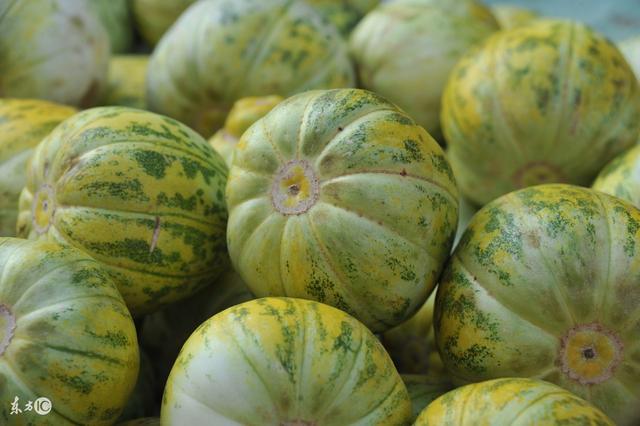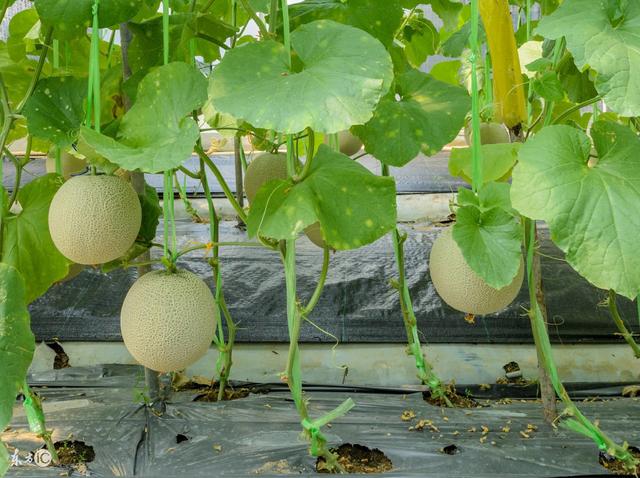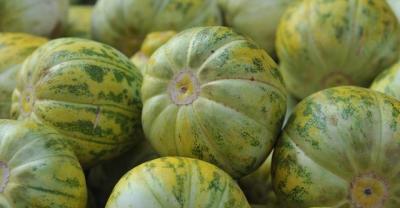Planting management technology of cantaloupe
Cantaloupe, also known as melon because of its sweet taste, is rich in nutritional value, and plays a good role in promoting the activity of human heart, liver and intestinal system, endocrine and hematopoiesis. Moreover, cantaloupe has strong root system, strong adaptability and stress resistance. Therefore, its planting area is increasing rapidly. So, how to grow cantaloupe? What management techniques should be mastered in melon planting?


I. selection of varieties with high yield and disease resistance
There are many varieties of cantaloupe, but at present, the main varieties suitable for promotion in various parts of our province are: American zucchini, Zaoqing zucchini, crispy Yu No. 1, Jingdian Jasper, Black Xiuli and other high-yield and disease-resistant varieties, which can be selected by farmers according to their actual needs.
Second, cultivate strong seedlings and establish a foundation for high yield
1. Do a good job of seed disinfection and germination: generally, 1% copper sulfate or carbendazim can be used for seed disinfection. During live broadcast, seeds can be mixed with Tiemike or 3% Badan powder to avoid the harm of underground pests.
two。 Seedling raising and sowing: if you carry out fine cultivation, you can choose a nutrition bowl or nutrition bag to raise seedlings, nutrition soil preparation to 1000 kg, mixed with fine manure 300 Mel 400 kg, carbendazim 2. 5 kg (you can also choose metalaxyl 200m 500g or Batan 100m 200g or Tiemak 100m 200g) 30 kg of common calcium, 30 kg of compound fertilizer, 30 kg of compound fertilizer, mixed well with appropriate amount of water (40% of soil water content), heap and cover 5 Mel for 7 days. Then sow seeds in bags (bowls) and sow one seed in each bag (bowls). Those who carry out direct seeding should apply adequate base fertilizer, applying rotten farm manure 3000 kg per mu, common calcium 40mur50 kg, and compound fertilizer 30 Mu 50 kg. Deep application in the shape of a ditch or deep application in a pond. Then covered with soil and sown, each pond sowed 3 sterilized and germinated seeds.
Third, reasonable close planting
The planting density of cantaloupe varies with variety. In general, the row spacing of dwarf type is 0.60 mi 0.80 m, the plant spacing is 0.50 m, and the suitable planting distance is 1600 mi 2200 tang, 4000rel 4500 plants per mu, while the row spacing of vine type is 1.50 mi 2.00 m, and the plant spacing is 0.50 m. It is suitable to plant 700mu 800 tang and 1400 Mu plants per mu. Therefore, the majority of farmers in the selection and purchase of varieties, must understand that the variety is short vine type or long vine type. The cantaloupe of nest type (short vine) is sparse, can not get high yield, long vine type (string everywhere) is dense, the population is large, the ventilation and light transmission is not good, it is not resistant to disease, it does not bear melon, and the yield is very low. Therefore, it is necessary to understand the variety and determine its planting density according to the variety.
IV. Field management
1. Seedling management: cantaloupe seedlings grow rapidly, especially those raised in nutrition bags or bowls. In order to prevent overgrowth, water and temperature should be strictly controlled. After being unearthed, the temperature should be gradually released and trained. The temperature should be controlled at 20 ℃ 25 min during the day and 10 ℃ at night. At the same time, it is necessary to strengthen the management of fertilizer and water, watering the seedlings with compound fertilizer and adding metalaxyl or metalaxyl aluminum and copper every 5 days to prevent the harm of root rot, and spray Bordeaux solution to prevent powdery mildew and white rust.
two。 Field management in the field stage: seedling transplanting or direct seeding seedlings, early stage should be ploughed frequently to promote root development, all diseases are from the root system, the root system is underdeveloped, the growth is weak, the disease is relatively serious. In the future, the theme of strengthening management should be combined with irrigation, ploughing, soil cultivation and fertilization. When cantaloupe grows to 6 leaves, fertilizer should be applied in time. Compound fertilizer can be applied at a rate of 20kg / mu to promote the growth of roots, vines and young melons. At the same time, water should be irrigated every 3m / m every 5 days to keep the soil moist.
3. Field management of harvest period: when muskmelon enters the first harvest period, it should be fertilized every time, and try to add calcium such as quick-acting and efficient compound fertilizer or urea as the main method.
4. Proper application of plant growth regulators to promote yield and income: there are many kinds of plant growth regulators, generally, it is better to use those that can promote pollination and melon body, such as 2.4 murine D, fruit Peng Dazu and so on. Specific methods of use refer to the method of plant growth regulators.
Other requirements for planting cantaloupe
1. Muskmelon requires sufficient light, daily sunshine time should be more than 10: 12 hours, as usual keep 14: 15 hours / day, melons grow well.
two。 For soil moisture content, muskmelon needs sufficient water during germination. In addition to soaking seeds to accelerate germination, the optimum soil water content for seed germination during direct seeding is about 10%. The soil water content during flowering and fruit setting should be moderate, 60%-70% is suitable, high moisture is required during fruit expansion period, 80%-85% is suitable, and 55% less water content is better during the ripening period, that is, after setting. Stop watering 7-10 days before harvest.
3. Muskmelon is resistant to drought, salt and alkali, barren, and can grow well at pH 8 to 9. However, it is sensitive to chlorine, chlorine should be strictly avoided in cultivation, and hydrogen chloride should not be used as potash fertilizer. During the whole growth process, the proportion of large amount of nutrient elements required by muskmelon was N ∶ P ∶ K ∶ 30 ∶ 15 ∶ 55, which can be used as formula fertilization.
4. Land selection requirements: the previous crop is non-Cucurbitaceae crops, and the sandy soil with good drainage is the best. After autumn, 3000 kg of high-quality organic fertilizer is applied every 667m2, deep ploughing, overwintering, storing rain and snow, weathering soil and eliminating diseases and insect pathogens. Spring rake: heavy rake after soil pulping, leveling the land.
5. Plant management requirements: extensive management, simple pruning, that is, when the field leaf area coefficient is large in the middle and later stage, simply top with a stick to prevent field depression. Double-vine pruning can also be used: when the main vine has 3 or 5 leaves, two strong vines are selected and extended evenly to the border surface; the sun vine knot melon, leaving two leaves in front of the melon to pick the heart, one for each grandson vine and three and five for each melon plant.
VI. Prevention and control of diseases and insect pests of muskmelon
The main disease of cantaloupe was powdery mildew, followed by downy mildew, vine blight and virus disease. Prevention and control is mainly based on prevention, while strengthening field management. In serious cases, chemical control should be carried out. Powdery mildew can be sprayed with 15% trimethoprim wettable powder 1000-1500 times or 12.5% nitrilazole EC 4000 times, once every 15-20 days. Downy mildew, spray with 72% Kelou wettable powder 800 times, or 40% ethyl phosphate aluminum wettable powder 250 times 300 times, or 75% chlorothalonil 600 times liquid spray. Vine blight, spray with 500 times of 70% mn-Zn wettable powder or 600 times of 75% chlorothalonil wettable powder. For virus disease, spray with 1000 times of 1.5% phytotoxic emulsion or 300 times of 500 times of 5% bacteriological clear water, once every 10 days, for 3 times.
Pest control. The frequency of insect pests was higher in aphids, followed by night moth, armyworm, cotton bollworm and so on. Aphids are sprayed with 1500 times of imidacloprid wettable powder or 3000 times of 2.5% Uranus EC or 2000 times of 20% methamphetamine EC.
- Prev

Planting and maintenance of Osmanthus fragrans
Morphological features: up to 15 meters high. It is often shrubby because of its strong branching and low branching point. Bark friends brown or grayish white, simple leaves opposite, leathery, smooth, dark.
- Next

Vegetable planting technology
The main results are as follows: 1. The application principle of organic fertilizer and chemical fertilizer can not be reversed. First, organic fertilizer is given priority to, supplemented by chemical fertilizer, in order to make vegetables with high quality and high yield. Second, organic fertilizer must be mature.
Related
- Fuxing push coffee new agricultural production and marketing class: lack of small-scale processing plants
- Jujube rice field leisure farm deep ploughing Yilan for five years to create a space for organic food and play
- Nongyu Farm-A trial of organic papaya for brave women with advanced technology
- Four points for attention in the prevention and control of diseases and insect pests of edible fungi
- How to add nutrient solution to Edible Fungi
- Is there any good way to control edible fungus mites?
- Open Inoculation Technology of Edible Fungi
- Is there any clever way to use fertilizer for edible fungus in winter?
- What agents are used to kill the pathogens of edible fungi in the mushroom shed?
- Rapid drying of Edible Fungi

